Generality
There are many remedies used in traditional and alternative medicines to combat acne. These remedies - with the most varied mechanisms of action - share the fact that they are of natural origin.

Natural remedies
When we talk about natural remedies, we want to indicate a large and heterogeneous set of substances of natural origin (vegetable, animal, mineral) used to combat certain ailments or diseases, among which we also find acne.
There are many natural remedies available to combat this skin disorder and this allows you to identify the treatment that best suits each individual.
Phytotherapy
Phytotherapy is the classic example of therapy that makes use of natural remedies for the treatment of various ailments. More specifically, it resorts to the use of medicinal plants, portions of them and / or their derivatives.
Specifically, for the treatment of acne, the plants most used in dermatology are Burdock and Wild Pansy:
- The root of Burdock has an "antiseptic and purifying action on the skin. It favors the purification of the liver and kidneys and contains germicidal substances (which kill bacteria). It is used in mother tincture (30-50 drops three times a day), nebulized. , fluid extract, or in the classic decoction (a teaspoon of roots per cup of water. Boil for ten minutes and consume morning and evening between meals).
- Wild pansy exerts a diuretic, purifying and anti-acne action. It is used in mother tincture (20-30 drops three times a day) or infusion (2 teaspoons per cup, -3 cups per day).
For the treatment of acne, phytotherapy also uses the well-known antibacterial properties of propolis, a substance produced by bees from the resins they collect from the bark and buds of plants.
Propolis - in addition to being an excellent antibacterial - also has a good anti-inflammatory activity. It is applied in the form of creams, ointments, masks, compresses or vaporizations or internally as a mother tincture (10-20 drops 2 or 3 times a day).
Essential oils
To combat acne, the use of essential oils extracted from certain types of plants is also very popular in the phytotherapeutic field. Generally, the essential oils used in this field have bacteriostatic or bactericidal properties.
The essential oils with the widest antibacterial spectrum are Thyme, Oregano, Lemon and Savory. For external use are indicated Lemon, Lavender, Sage, Myrtle, Melissa, Cypress, Thyme, Helichrysum, Geranium.
They are applied to the skin in the form of a pack (a couple of drops in two fingers of water), or diluted in a light oil (for example, Avocado, Walnut or Jojoba), or even mixing them with clay masks (substances from known skin purifying properties).
On the market there are valid cosmetics based on essential oils intended for oily, acneic and impure skins.
For more information: Acne: natural remedies.
Homeopathy
Homeopathic medicine intervenes on acne symptoms but also on factors that are not directly related to the disease.
Therapy can be implemented on two fronts:
- With symptomatic remedies (which reduce symptoms);
- With basic remedies that act on the "ground" of the sick person.
In all cases it is the specialist who must indicate, case by case, the specific treatment.
The symptomatic remedies are prescribed on the basis of the appearance of the acne papule and the constitution of the skin. They are halogenated derivatives (ie containing one of the three halogens iodine, bromine or chlorine, experimentally responsible for toxic acne). If a healthy person comes into contact with one of these elements excessively, they develop acne.
There are three main remedies:
- Sulfur Iodatum
- Calcium Bromatum
- Natrum Muriaticum.
The first remedy (Sulfur Iodatum) is typical of very thin and nervous subjects; the second (Calcium Bromatum) for the depressed; while the third (Natrum Muriaticum) is specific for those who escape human relationships and who tend to isolation.
Homeopathic antibiotics are used to fight the bacterial component of acne and are:
- Hepar Sulfur, in the case of purulent acne;
- Arnica Montana, in the presence of painful and hardened purplish pustules.
If, on the other hand, acne is linked to food, Antimonium Crudum or Nux Vomica can be used, indicated for those who lead a particularly stressful life.
Background drugs
The underlying drugs are typical of the individual's personality, regardless of the disease. The "personalities" (physical types) that most frequently develop acne are:
- Natrum Muriaticum;
- Sulfur;
- Thuja;
- Silicea;
- Tuberculinum.
The vaccine
The homeopathic vaccine is obtained by taking purulent material (pus) from the patient during the acute phase of the disease. Once homeopathized, it is administered either in drops or by injection to the patient himself, in order to make him immune to the bacterial agent present in acne.
Similarly, a drop of blood can also be taken. The technique is the same, while the aim is to desensitize the body from excess circulating hormones. It is known, in fact, that acne also has a hormonal origin.
Warnings
Acne does not necessarily appear as a disorder for its own sake. In many cases, in fact, it can be the symptom or the consequence of any underlying disorders or pathologies that have not yet been diagnosed.
For example, hormonal disorders and hepatobiliary disorders are among the most common disorders capable of causing the onset of acne.
For this reason, in case of acne manifestations - especially if sudden and of high intensity - it is always good to contact your doctor and avoid any type of "do-it-yourself" therapy, in order to save time in ineffective therapies and with dubious results and in order to avoid the onset of potential undesirable effects.
In this regard, it is good to remember that even homeopathic remedies - although not considered as drugs - should be prescribed exclusively by the homeopathic doctor.
Acne scars
How can acne scars be countered?
Among the main and most evident damages that acne can cause we find, without any doubt, the much hated scars.
In general, if acne has been cured and treated immediately, it hardly leaves scars. The skin, in fact - once it has healed - tends to renew itself spontaneously.
If the acne has left superficial marks, it is sufficient to apply creams containing low concentrations of glycolic acid, which gradually smooth the skin. Glycolic acid, in fact, is able to exfoliate an exfoliating action on the skin thanks to its ability to weaken the forces of cohesion between the corneocytes found in the superficial portion of the epidermis.
If, on the other hand, the acne scars are particularly deep and evident, various types of dermo-aesthetic treatments can be used - preferably on the prescription of the dermatologist - which must be strictly performed in dermatology or aesthetic medicine offices.
Among these treatments we find:
- Glycolic acid peeling: it is a painless treatment that guarantees an immediate presentability. It has a dual mechanism of action: on the one hand it causes a progressive peeling of the skin that is not visible to the naked eye, on the other it stimulates the production of collagen and elastin. As a rule, a complete cycle includes four to six peels performed fifteen days apart.
- Acetylsalicylic acid peeling: the active principle of Aspirin® is known for its anti-inflammatory, analgesic and antipyretic (against fever) activities. In acne therapy, its properties are exploited to decrease the cohesion of the horny lamellae (in the epidermis), to reorganize the keratinization process, to eliminate impurities and blackheads preventing their reformation. Used at low concentrations (3-5%) it can also be used by beauticians as a delicate peeling. This peeling has a complete exfoliating action on the superficial horny layer, does not damage the dermis and therefore protects against any risk of injury or the formation of spots. To exclude potential allergic phenomena, it is useful to first perform a skin reaction test.
- Dermabrasion: it is the most invasive method. In this case, the leather is smoothed with a "brush" that rotates at very high speed. In the following four months, it is absolutely forbidden to expose yourself to the sun and the results are visible only after healing. This technique is used to eliminate particularly evident or raised scars and must be performed only and exclusively by specialized medical personnel.
- Microdermabrasion: it is an aesthetic treatment - safer and more delicate than the aforementioned dermabrasion - which eliminates acne blemishes with the help of an aspirator and mineral powder without the risk of infections or bleeding, burning and swelling. It does not break down the cellular balance. at the level of the dermis, as it acts superficially on the epidermis. Each session takes 20-30 minutes and generally a dozen or so are recommended, starting with one session a week. Also in this case, despite microdermabrasion is considered a more delicate treatment and relatively simple to perform, it must only be carried out by specialized personnel working in suitable structures, in order to avoid the onset of unpleasant and dangerous adverse effects.
The healing times vary according to the type of treatment to be carried out. In any case - regardless of the type of technique used - to avoid the onset of complications and side effects, it is advisable to avoid sun exposure both before and after treatment. For the same reasons, it is very important to use sunscreens with a high protection index and to strictly follow all the instructions provided by the doctor.
- Acne: natural remedies
- Acne
- Acne: causes and medications
- Acne: acne medications and treatments
- Acne - Acne treatment drugs
- Acne: natural remedies
- Diet and acne
- Diet and acne




























